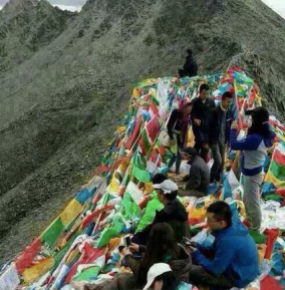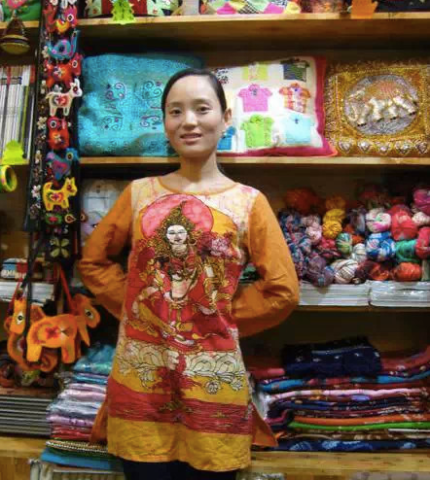In this blog I discuss a series of images that have sparked uproar and debate among Tibetan and Han netizens over the past few days. The images feature a women posing both semi-naked and fully naked along the shores of Yamdrok Lake, one of Tibet’s four holy lakes. Cyberspace has been ablaze with heated commentary over whether or not this constitutes an act of disrespect to Tibetan culture.
While the story has picked up widespread coverage in both Chinese and Western media, I want to use this blog to reflect on the necessity of situating this particular incident within a long series of state-sponsored practices of ethnic commodification, cultural appropriation, and violent defilement of Tibetan culture for Han desire.
This week Tibetan cyberspace has been ablaze over pictures of a model posing both semi-naked and naked along the shores of Yamdrok Lake in Tibet. First posted on Weibo on April 11th by YouchumDolkar, the images, taken by photographer Yu Feixiong, quickly went viral among Tibetans and Han netizens. The incident was also widely covered across major media outlets in China, generating huge commentary online. However, while there was a large consensus among Tibetans that the images constituted a grave offence and insult to Tibetan culture, for Han netizens debate ensued about whether there was a problem at all.
It is important to note that images of Han tourists behaving badly in Tibet are regularly posted, circulated and criticised by Tibetans on Weibo and Wechat. Standing on prayer flags, wearing clothes bearing images of religious iconography and revered figures, photographing sky burials, and climbing and sitting on sacred statues are but a few examples.
In fact, as the pictures below show, the Yamdrok Incident is not even the first time Tibetan’s have drawn attention to Han tourists feeling the urge to strip off in Tibet’s great outdoors.
So well versed in instances of Han tourists behaving badly have Tibetan netizens become that they have even compiled a number of lists advising on “Do’s and Don’ts” for tourists visiting Tibet. Usual entries include “don’t stand or walk on prayer flags“, “don’t stick your camera in someone’s face” etc. I have yet to see one with “Don’t take off in your clothes on highways“, but perhaps it will be making an appearance soon.
Bearing in mind that disrespectful behaviour from Han tourists is a worryingly common and oft discussed happening, why did this series of photographs of a woman posing semi-naked and fully naked at a lakeside provoke an outcry among Tibetans that far exceeded any of the above examples?
The answer lies in the fact that it happened at Yamdrok Lake. Located some 100km southwest of Lhasa, Yamdrok Lake is an immensely sacred and culturally significant lake for many Tibetans. Along with Lhamo La Lake, Nam Lake and Manasarovar Lake, Yamdrok Lake is one of Tibet’s four “Great Wrathful Lakes” believed to be guarded by the goddess Dorje Gegkyi Tso.

An important site of pilgrimage for many devout Tibetan Buddhists every year, the holy lake has long been victim to state-sponsored exploitation. In Meltdown in Tibet: China’s Reckless Destruction of Ecosystems from the Highlands of Tibet to the Deltas of Asia, Michael Buckley writes that commercial fishermen freuqently tossed explosives into the lake to kill fish. During the 1980s and 1990s the Yamdrok Hydropower Station was built on the lake. The dam project, completed in 1998, faced enormous opposition from local Tibetans throughout its construction and continues to be a source of enormous controversy. Meanwhile, state media, unsurprisingly, celebrated the project as another victory in Tibet’s journey to modernisation. Far from the first assault, the latest scandal represents just another instance of profound disrespect and exploitation of this holy lake.
Reading Tibetan responses to the photo series, it is pretty clear why Tibetans were so outraged. It was not because the woman was naked, but where she got naked, and this point was repeated ad nauseam in Tibetan comments online.
Many Han netizens were sympathetic to Tibetans concerns. Indeed, never have I seen the idiom “when in Rome, do as the Romans do” (ruxiangsuisu) repeated quite so much. Another netizen received many likes and shares for commenting that “Tibetans should have the biggest say in matters like this“.
Others, however were much less understanding. Mirroring typical dominant group rhetoric elsewhere, hundreds of Han commenters told Tibetans “not to be so sensitive” and “to stop overthinking the pictures”. Echoing widespread sentiment among Han commenters, one netizen queried “Why can’t they do this shoot? The human body is a natural gift to humankind. Why can we not face our own bodies?” Others recast the whole incident as a reflection of Tibetan and Chinese conservativeness around female sexuality “You just need to shoot a few artful pictures of a naked women and it will be labelled as defiling culture, indecent and other anti-morality nonsense. This woman’s mistake was being born in a sexually-unliberated China.” Many, engaging a mocking and dismissive tone, wondered whether Tibetans should also “require yaks and horses by the lakeside to cover-up as well“. Another highly condescending attitude prevalent in the Han response simply claimed that Tibetans were too “backward” and just “didn’t understand art“.
Bearing striking similarities to other pervasive and violent forms of micro-aggressions such as whitesplaining and mansplaining, Han comments regularly betrayed a distinct sense of paternalism and chauvinism towards Tibetans, explaining in condescending terms that Tibetans had simply misread their own experiences of oppression, and suggesting a more ‘correct’ reading of what had actually happened. So ubiquitous is this dynamic in online interactions I witness between Han and ethnic minorities that I now have a word to describe it: hansplaining.
Tibetans were quick to respond to these various mischaracterisations of the issue. One Tibetan replied “First talk about respect and then we’ll get to art“. Another Tibetan commenter posted that “This is first and foremost an issue of cultural sensitivity. Don’t talk about this as an issue of ethnic groups needing to learn how to be more tolerant.” Several others responded by sharing a post that has now become an emblem of Tibetan cyber-struggle against these constant acts of disrespect:
You do not need to be Buddhist, nor do you do not need to understand our faith, but please, as the minimum mark of respect, try to understand a little of the local culture and customs before you come.
By far the most liked and reposted retort was:
Some say that we are too backward. Seems like we can’t even appreciate a bit of nudity as art. If you think that nudity represents the modern and civilised, then consider this: since ancient times Lhasa’s lakesides and natural springs have never had any shortage of naked bodies. Even our Bathing festival is about everyone getting naked together. What happened at Yamdrok is not about nakedness as modern or backward, it is about the basic principles of being respectful and being respected. I’m really sick of this kind of oppression.
And of course, predictably, in a classic act of conversation derailment, some Han netizens pointed out that ethnic minorities also disrespect Han culture, brazenly adding that “we all know verbally abusing Han people carries no risk“. Indeed, many of comments reflected very familiar manipulative tricks that attempt to deflect attention away from acknowledging responsibility for and the need to address oppressive Han behaviour. Arguably, the vast majority of Han commentators failed to acknowledge in any shape or form the immense spiritual and cultural significance of the Yumdrok Lake, the many instances of violent assault carried out by the Han-State on the lake over the course of the past few decades, or any kind of connection with wider forms of prejudice or discrimination against Tibetans.
The photographs and discussion of the Yamdrok Incident, in tangent with previous instances evidenced in the above photographs, reflect so much of ethnic minority-majority relations in China today. Spurred on by the now longstanding state-sponsored drive to ‘modernize’ Tibet through tourism development, these images embody a desire to consume and commodify all things Tibetan, a profound sense of narcissistic entitlement to the Tibetan homeland that appears to trump any need for acknowledging, let alone addressing, Tibetan calls for respect and recognition. Crucially, while Han tourists enjoy the Tibetan homeland as a site of pleasure and indulgence, Tibetans find themselves increasingly dispossessed and out of place in Tibet, tirelessly struggling against land grabs, resettlement, travel restrictions and stringent security checks, inward Han migration, inland schooling, and so on. Far more than simply “foolish Chinese women…posting silly photos of themselves” on social media as one media outlet suggested, the Yamdrok Incident so vividly encapsulates the ongoing violence of Han hegemony in Tibet today.














